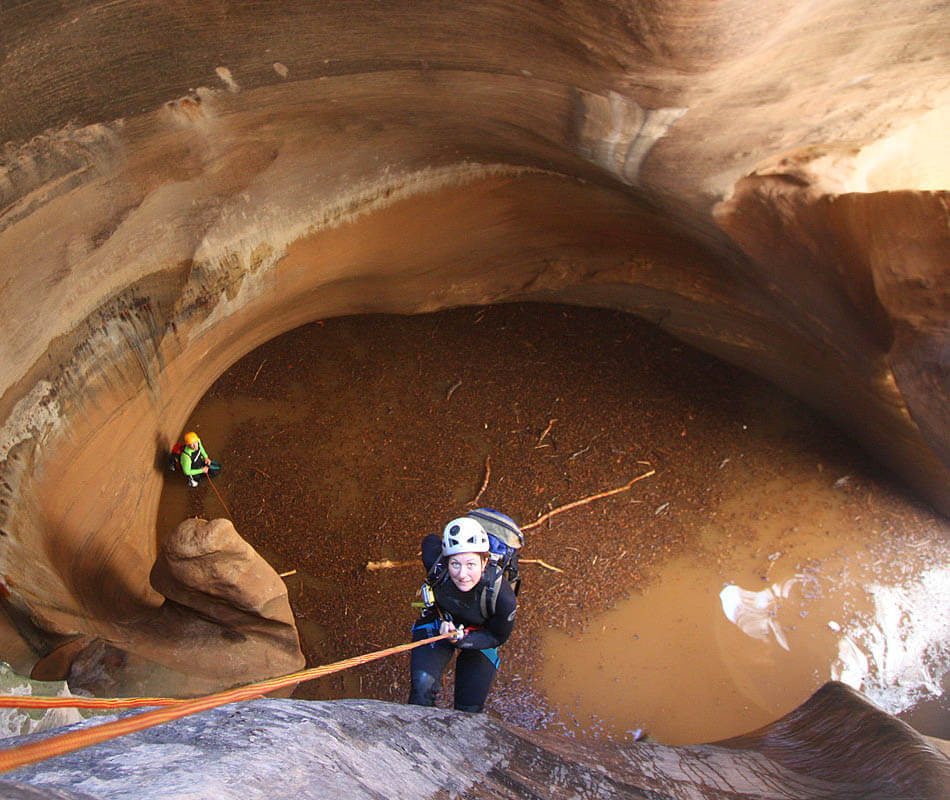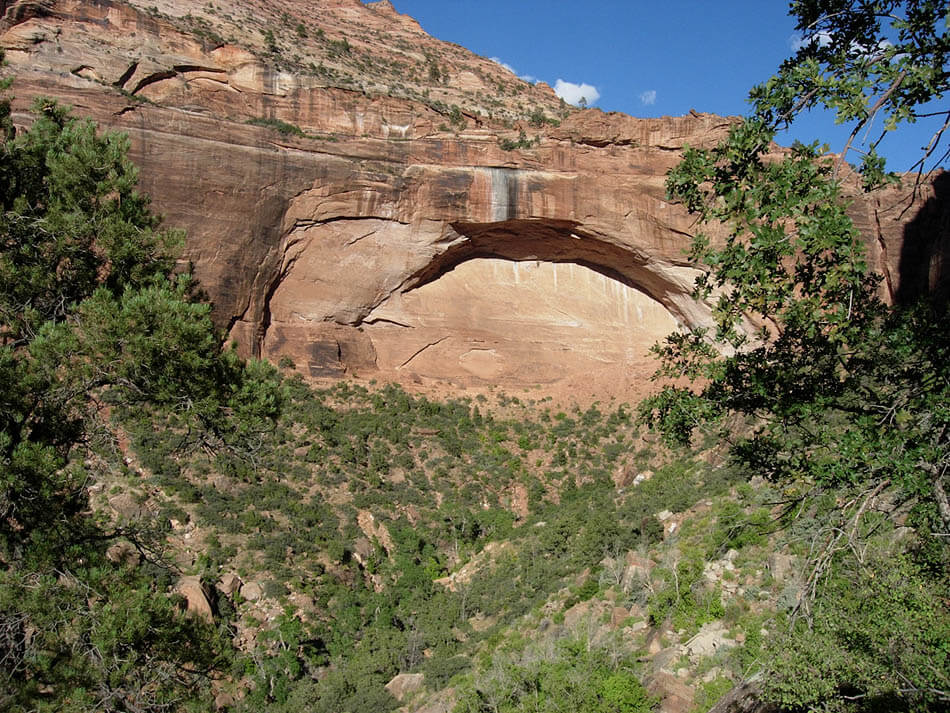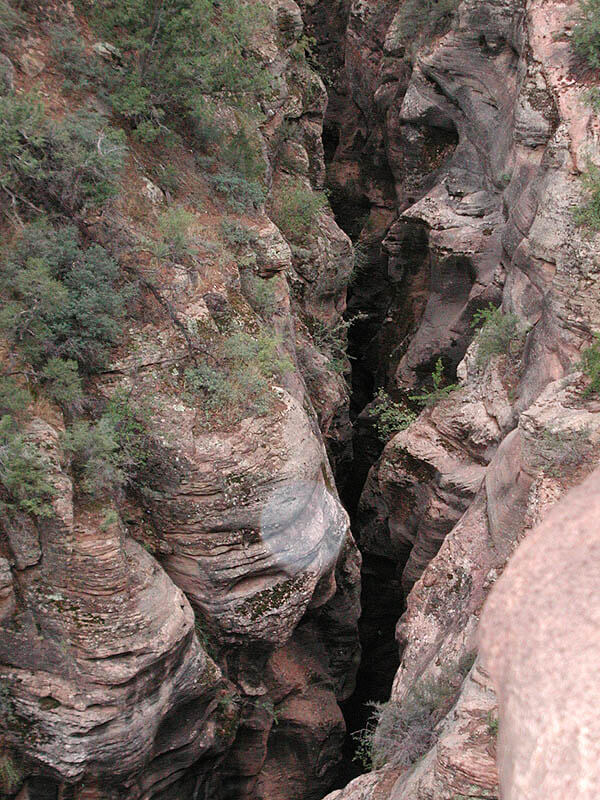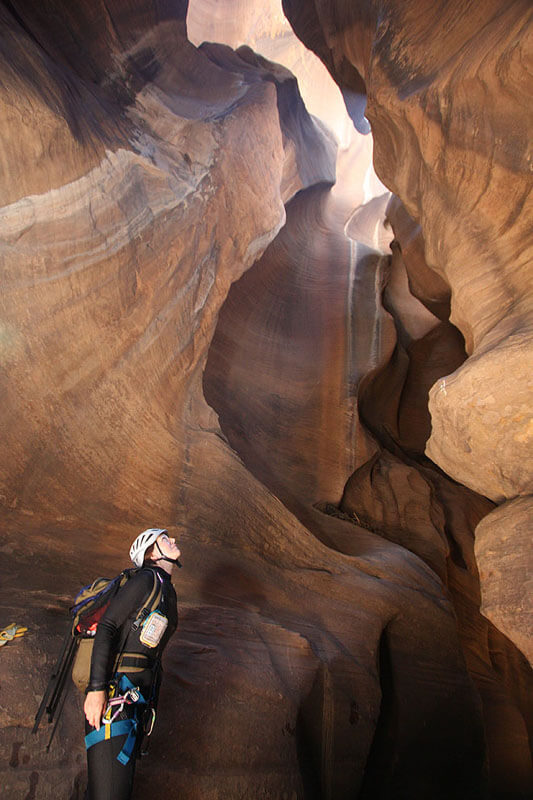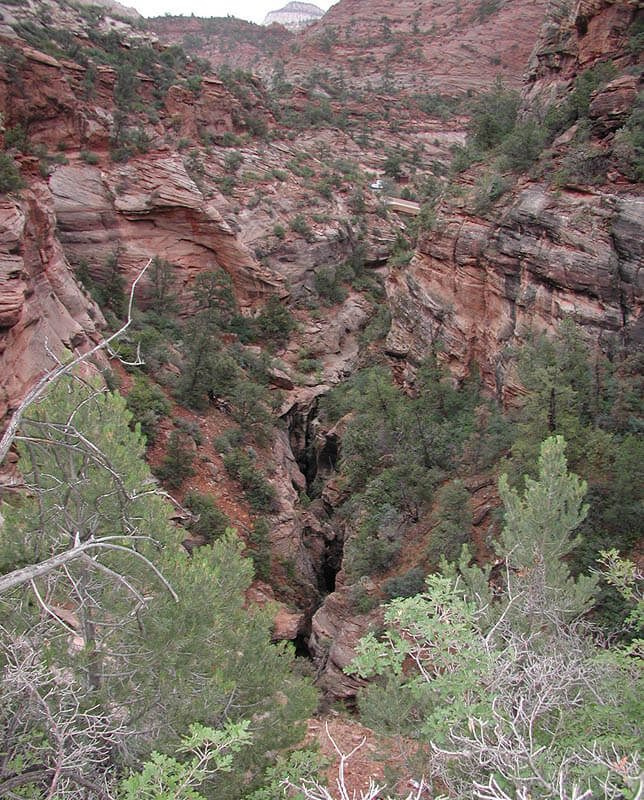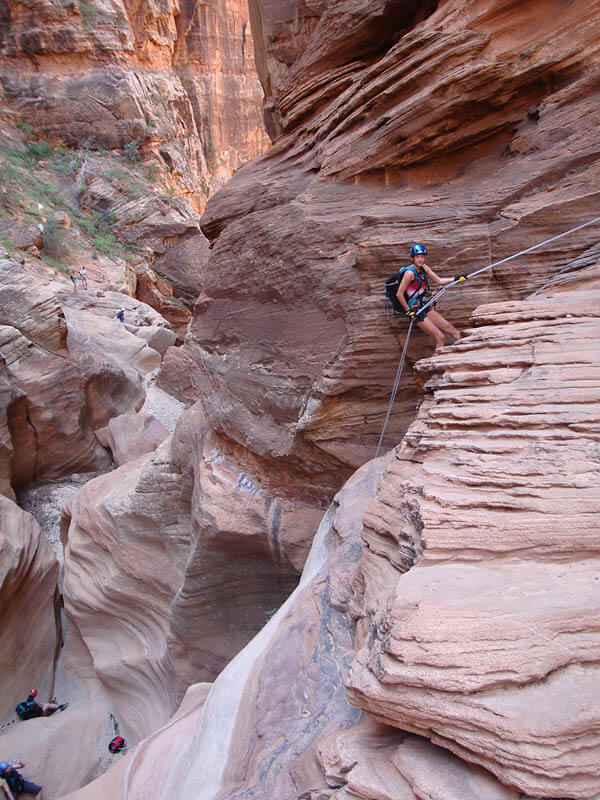A Classic Introduction.
Rapid-fire rappels, beautiful soaring walls, the subterranean nature and constantly changing light & water conditions make Pine Creek a wonderful experience for well-led beginner canyoneers and grizzled veterans alike. The ultimate Zion Classic.
Pine Creek demonstrates the ever-changing nature of Zion canyons. Full of water from spring runoff or recent thunderstorms, it is a freeze-fest requiring thick wet suits to prevent hypothermia. After a period of extended drought, it can be completely dry. Be sure to check at the Zion Backcountry Desk for current conditions and, more importantly, believe them when they say you NEED wetsuits.
The technical section is done by competent small parties in an hour or less and struggled through by large groups of less-competents in 12 hours or more. Expect to encounter other parties when descending Pine Creek. Play well together. The light is best near mid-day, so sleep in, slurp coffee—no need for an early start. Or enjoy it late in the afternoon for a less-social experience.
Being adjacent to the road, Pine Creek has a higher daily use quota (50 people) and a higher allowed group size (12) than most canyons in Zion. It DOES "sell out" on summer days, but there is less of a scramble for permits than for other canyons.
First descent of the canyon down the watercourse, as currently done: Dennis Turville and Dean Hanniball, September 21, 1977.
Canyon Profile
Logistics

RATINGS
3B II ★★★★★

TIME REQUIRED
2 to 6 hours (more if a large or novice group)

PERMIT
YES

SEASON
Spring, summer, or fall

LONGEST RAPPEL
100 feet (30 m)

SKILLS REQUIRED
WARNING! – This is not a beginner canyon. Pine Creek is Zion’s most popular canyon for misadventure. Rappelling off the end of the rope, losing control of a rappel or stalling out with a large inexperienced group are common ways of demonstrating incompetence in Pine Creek. Don’t do this. Pine Creek is a serious canyon with serious obstacles and should not be taken lightly.
Equipment

ESSENTIALS
Helmets, rappelling gear, webbing and rapid links.

COLD WATER PROTECTION
Wetsuits are generally required, even in hot weather.

DRINKING WATER
Bring your own water.

FLASH FLOOD RISK
Moderate - Pine Creek has a large collection zone, but the streambed above the slot has a huge capacity to absorb water.

ACCESS
Requires a car spot
or a short hitchhike.
Know what you are doing. It may seem self-evident, but Pine Creek requires canyoneering skills to descend. Everyone in your party should know how to rappel BEFORE entering the canyon. Many rappels feature awkward starts or require disconnecting while swimming.
Keep your group small, to six or fewer people. If your group is larger, break it into two smaller groups. If you do not have enough experienced people to do this, break the group in two and have the experienced people run through the canyon twice.
Bring the right equipment. Everyone must have his or her own harness, gloves and rappel device, plus a helmet and proper clothing. Do not underestimate the need for wetsuits.
SEASONAL ADJUSTMENTS
Spring : Sometimes means melting snow and flowing water through the canyon. Rappels may be flowing and some downclimbs become a lot harder. And of course, the water is COLD!
Summer and Fall : Usually friendly conditions in Pine Creek, but water levels vary widely. Be careful of summer monsoons – not a canyon for a thunderstorm day.
Winter : VERY full-on with flowing water and icy conditions.
Getting there
Spotting Cars
Pine Creek is the drainage that parallels the famous Zion Tunnel. From Springdale drive north a few miles to Canyon Junction. Follow Rte 9 up Pine Creek Canyon to the second switchback and park. This is where you will exit. Continue up the road and through the tunnel. Park at the east end of the tunnel in a small parking lot on the right - although it is usually full. Park where you can. If you have only one car, park at the top and one person can hitch back to the car after completing the canyon.
The Approach
From the parking lot, follow a small trail close to and then under the bridge to the canyon bottom. Five minutes of walking and downclimbing leads to the first rappel. Wetsuits and harnesses are commonly put on in the shade of the canyon a few meters short of the first rappel. There are odd-seeming bolts well before the first rappel. These are for Search and Rescue’s frequent rescues of poorly-led parties.
The Business
BETA WARNING: Canyons are constantly changing, and Pine Creek changes more than most. This beta describes it as it was last time I went through before I wrote this… October 7, 2021.
First Obstacle: A short drop and pool must be dealt with before getting to the first rappel. There are two sets of SAR bolts that can be used to rap into the small pothole. Downclimbing into the pothole works well when it is full of water; a balancey step left allows for stemming down to water level. Find something that works for you.
R1: 20 feet (6m): Rap from a 2-bolt anchor perched on a rib to a pothole ledge.
R2: Walk to the exit of the pothole and rappel from new glue-in bolts 15 feet (5m) to the ground, which is often a pool.
Walk 10 meters to the next obstacle.
R3: 15 feet (5m): Rap from a 2-bolt anchor past a chockstone. Can be downclimbed, but a surprise bad-landing resulted in 3 ankle injuries in 2015, so rapping or handlining is recommended.
Walk 20 meters past a small arch.
R4: 10 feet (3m) off a log into a pothole.
R5: 50 feet (15m) The Cathedral Rappel. Walk carefully out a slippery ramp to the anchor (may require a belay in some conditions). Rap off a bolt anchor past 2 arches.
Walk or swim out the end of the pothole (through arch). A downclimb leads to a beautiful, often flooded, fluted corridor 100m to the next obstacle. Walk, clamber, swim etc. for a couple hundred meters to where the canyon turns sharply right. Walk and clamber 100 meters or so to a short drop. All along this way, towering walls put on a colorful display when the light is right. Be sure to look up!
R6: Rap 20 feet (7m) off a two-bolt anchor to a pool, often a short swim.
Make your way to where the canyon opens up. This is a good place to have lunch and warm up.
Work through large blocks 200 meters, next to the right wall. Trending right near the end to a flat ledge and a bolt anchor near a small tree.
R7: Rap 65 feet (20m) down a corner. Pull the rope carefully to avoid getting it stuck in the corner crack. Walk through a neat keyhole to an open area. Climb slabs left to a bench, then walk down to an arch and a bolt anchor for the final rappel.
Safety Note: The canyon "floor" in the open area is debris wedged in-between giant boulders and is unstable. It forms the roof of a cavern below. Use caution when moving across this possible collapse area.
R8: Rap 100 feet (30m). A spectacular free rappel leads to a rocky area that used to be (and will be again) a delightful Fairy Glen with a small spring.
Alternate Rap 8: Rappel 90 feet (27m) using a two-bolt anchor off the front face of the boulder that blocks the canyon; it leads into the chamber under the rock. Downclimb/scramble down a corner to a pool at ground level—easier than it looks. The pool is usually waist deep.
Relax, drink some water, remove harnesses and pack the rope. Sometimes it is best to wait until the canyon goes into the shade for the walk out.
The Exit
Descend the canyon. The floor of the canyon is littered with large blocks and the walk out is strenuous. Very difficult in the dark. Take it slow and have fun. Work your way down the streambed, following signs of traffic. It takes one to two hours, plus time for playing in pools. The masonry wall of the 2nd switchback is clearly visible from the canyon bottom just before the largest and best swimming hole. Find a trail in the woods from the level of the pool leading to the road.
Emergency (NOT alternative) Exit: It is possible to follow a traversing trail across to the end of the top switchback of the Pine Creek road. The trail is closed except for emergencies, REAL emergencies. This trail is eroded and collapsed in a couple of spots and is easily seen from the Canyon Overlook trail as it has a huge impact on the sandy hillside. Following the drainage is the low impact exit—please use it.
author’s experience
Pine Creek was my first technical canyon in Zion, in June 1999 with Scott Holley. I have descended it once or twice a year since then.
Trip Reports
Stories
PINE CREEK NARROWS : The earliest-known written description of the Pine Creek Narrows, by Jim Bellamy and Jon R. Dick - no date (1970s?).
Pine Creek's popularity also makes it an all-too-frequent place to be rescued from. Read a few Pine Creek rescue reports from Zion: Canyoneering to keep your mind sharp and your canyoneering cautious.
Citrus Milo and Pine Creek - Joe recounts his Pine Creek experience.
Descents by Dennis Turville, 9/21/77 - Dennis Turville's first technical descent of Pine Creek Narrows with Dean Hanniball.
Amy's Hair by Ram - Tales of an Incompetent Adventurer
Musings and Recollections, 1/13/09 - Matt Smith shares his musings and recollections with Canyon Tales of an event in Pine Creek.
Maps
Click for higher resolution


